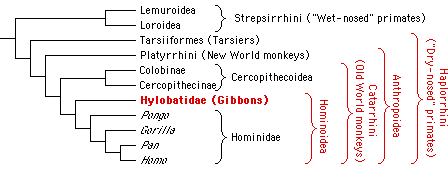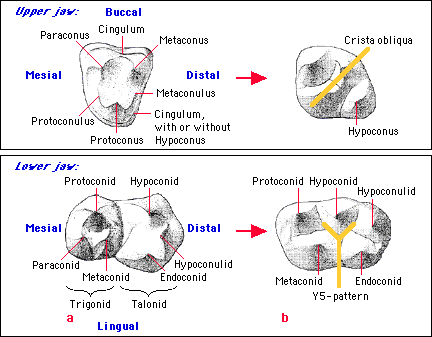Back to the Introduction
index
![]() German version
German version
1. The Gibbons within the Hominoidea |
The Hominoidea (apes and humans) are the less successful radiation of the catarrhine primates. According to the systematic arrangement used here, the hominoids include only 8 genera with a total of about 20 species. Their distribution is restricted to the tropical forests of Africa and South-east Asia (with the exception of the genus Homo). During early Micocene (about 22 million years ago), however, hominoid diversity was much larger and apparently surpassed that of the cercopithecoid sister group. Various species and genera of hominoid apes were widely distributed then, even in Europe.

Figure 1.1. Position of the gibbons (Hylobatidae) in the phylogenetic tree of the primates.
The monophyly of the hylobatids and their basal position whithin the phylogeny of living Hominoidea are well established (Figure 1.1). The monophyly of the group consisting of the African apes (genera Pan and Gorilla) and humans (Homo), but excluding the Asian orang-utans (Pongo), is also well supported. Therefore, the term "great apes" does not represent a systematic unit. It is often used to represent a group consisting of the African apes and the orang-utans, but excluding humans. These apes have traditionally been united in the family "Pongidae". This grouping is based on similarity. Because humans are more closely related to some of its members (i.e. the African apes) than to its other members (i.e. the Asian orang-utans), the great apes do not represent a monophyletic group.
Unfortunately, even modern text books (e.g. Fleagle, 1999) still continue to group the great apes into the family "Pongidae". In spite of its long tradition, this arrangement lacks a systematic basis. In this text, I adopt a more consequent arrangement: All great apes are united with humans into the family Hominidae. If we wanted to remove any of the living apes from this family, the first alternative would consist in putting orang-outans - and orang-utans only - in their own family "Pongidae".
The phylogenetic relationships within the hominoid families Hylobatidae and Hominidae are less clear. Within the Hominidae, for instance, several molecular studies support a closer relationship between Homo and Pan, whereas Pan and Gorilla show several morphological similarities which seem to synapomorphic characteristics.
Table 1.1 presents a list of all currently recognized genera of Hominoidea.
Table 1.1. Families and genera of the Homioidea.
| Family Hylobatidae | |
| Genus: Hylobates | Small or dwarf gibbons, lar group |
| Genus: Hoolock | Hoolocks |
| Genus: Nomascus | Crested gibbons, concolor group |
| Genus: Symphalangus | Siamangs |
| Family Hominidae | |
| Genus: Homo | Humans |
| Genus: Gorilla | Gorillas |
| Genus: Pan | Chimpanzees |
| Genus: Pongo | Orangutans |
The Hominoidea share several primitive characteristics of catarrhine primates with their sister group, the Cercopithecoidea ("Old World monkeys"), including:
The Hominoidea differ from their sister group, the Cercopithecoidea, in retaining several probably primitive catarrhine characteristics, which include:

Figure 1.2. Evolution of the hominoid molar pattern (b) from the hypothetical molar pattern of primitive anthropoids (a) (after Ankel, 1970, p. 79).
The Hominoidea also differ from their sister group, the Cercopithecoidea, in several synapomorphic specialisations. Hominoid brains, for instance, are relatively big in relation to body size. Most derived hominoid characteristics are found in the postcranial skeleton. Many of them appear to be related to a more upright body posture adopted during certain forms of locomotion (bipedalism, suspensory locomotion):

Figure 1.3. Thorax and right part of the shoulder girdle of a macaque and a human, proximal view, both brought to about the same size (after Schultz, 1972, p. 112).
Table 1.2. Various genera of the Catarrhini, sorted by their intermembral indices (indices from Fleagle, 1999).
Intermembral index = (humerus length + radius length) x 100 / (femur length + tibia length); Abbreviations: Ce=Cercopithecinae, Co=Colobinae, H=Hominoidea
Homo H 72 Chlorocebus Ce 83 Papio Ce 95-97 Presbytis Co 75-78 Miopithecus Ce 83 Theropithecus Ce 100 Lophocebus Ce 78 Cercocebus Ce 83-84 Pan H 102-106 Colobus Co 78-79 Macaca Ce 84-100 Gorilla H 116 Cercopithecus Ce 79-86 Piliocolobus Co 87 Hylobates H 126-130 Procolobus Co 80 Erythrocebus Ce 92 Hoolock H 129 Semnopithecus Co 80-83 Nasalis Co 94 Pongo H 139 Trachypithecus Co 82-83 Pygathrix Co 95 Nomascus H 140 Allenopithecus Ce 83 Mandrillus Ce 95 Symphalangus H 147
Table 1.3. Some vertebral numbers of selected members of the Anthropoidea (average values, after Schultz, 1961).
* Cacajao; ** several species of macaques (Macaca) have more or less estensively reduced tail; *** One species (Simias concolor) with stronlgy reduced tail
Cervical Thoracal Lumbal Sacral Caudal Platyrrhini Callitrichidae 7 13 7 3 29 Cebinae 7 12 5.5 3 26 Aotinae 7 14 7 3 25 Callicebinae 7 12 7 3 25 Pitheciinae 7 13 6 4 24 (13*) Atelinae 7 14 4 3 29 Alouattinae 7 14 5 3 27 Cercopithecoidea Papionini 7 12 7 3 20 ** Cercopithecini 7 12 7 3 25 Colobinae 7 12 7 3 26*** Hominoidea Hylobates 7 13 5 5 3 Symphalangus 7 13 4 5 2 Pongo 7 12 4 5 3 Gorilla 7 13 4 6 3 Pan 7 13 4 6 3 Homo 7 12 5 5 4

Figure 1.4. Ventral view of the rump skeleton of an adult female macaque compared to selected members of the Hominoidea, all brought to the same size (after Schultz, 1969, p. 78).

Figure 1.5. Foot skeletons from selected members of the Anthropoidea, all drawn to about the same length (from Martin, 1990, p. 495, after Morton, 1924).
Some of the postcranial hominoid characteristics mentioned above are summarized in Figure 1.6.

Figure 1.6. Characteristic skeletal features of extant Hominoidea, illutrated by a siamang (after Fleagle, 1999, p. 237).
Hominoids also differ from cercopithecoid primates in several behavioral and ecological characteristics. It is often unknown, however, whether these are derived hominoid traits or pimitive anthropoid features.
In general (relative to their body size) hominoid primates exhibit a longer gestation period and a longer maturation period (i.e. the time until they reach sexual maturity).
Hominoid social structure is normally organized around matrilines, and the females don't usually stay in their natal groups. When forageing for food, several species appear to adopt a fission-fusion-organisation.